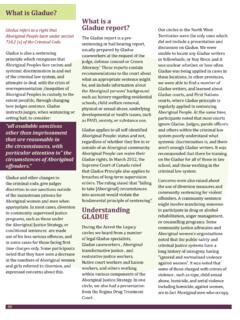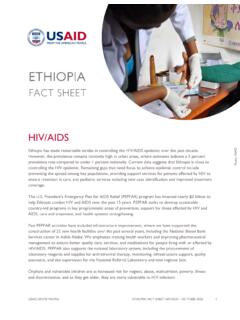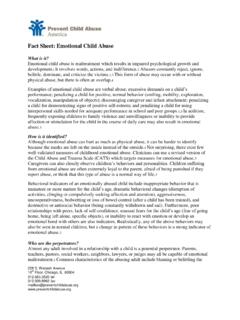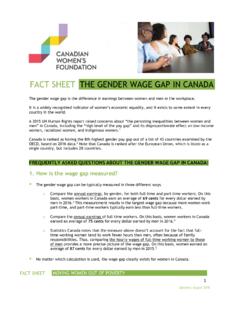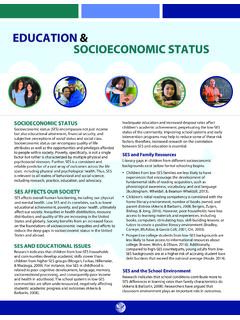Transcription of Fact Sheet - Native Women's Association of Canada
1 fact SheetFact Sheet : Root Causes of Violence Against Aboriginal Women and the Impact of ColonizationFor further information about Evidence to Action, please contact the NWAC satellite office:1 Nicholas Street, 9th floorOttawa ON K1N 7B7 Phone: 613-722-3033 Toll Free: 1-800-461-4043 Fax: office:155 International Road, Unit 4, Akwesasne, Ontario K6H 5R7 Phone: 519-445-0990 Fax: 519-445-0924 fact Sheet : Root Causes of Violence Against Aboriginal Women and the Impact of ColonizationThe Native Women s Association of Canada (NWAC) believes that knowledge of past and present issues is essential to building a better life for future generations. Aboriginal women in Canada have historically been devalued not only as Aboriginal people but also simply because they are women.
2 It is important to acknowledge the impacts of colonization and recognize that they currently exist and affect Aboriginal women and girls. By understanding the intergenerational effects of colonization, we can begin to address current issues and create a better future for Aboriginal women and explained by Guthrie Valaskakis (1999) early colonial writings described Aboriginal women as Indian princesses fetching, proud and virtuous. Resistance to colonization led to the invention of Aboriginal women as squaws dirty, lewd, uncivilized and sexually deviant. Both of these characterizations described Aboriginal women as sexually available, which served to remove responsibility from men who forced sex on Aboriginal women. To this day, many Aboriginal women and girls are forced into situations or coping strategies that increase their vulnerability to violence, such as hitchhiking, addictions, homelessness, prostitution and other sex work, gang involvement, or abusive discussed in the National Council of Welfare (2007) the history of colonization has burdened our nations with a continual passing down of various loads or degrees of post-traumatic stress.
3 Generation after generation, so that we wind up with this entire burden of our people as they exist today. Alcohol has been cited as a risk factor for violence. Certainly, the connection between colonization, alcohol use and increased vulnerability can be seen in situations of family violence. The residential school experience had a direct impact on the next generations of Aboriginal children, resulting in what is often referred to as the intergenerational effects or intergenera-tional trauma of residential residential school system and 60s Scoop were two strategies used to assimilate the Aboriginal population. The residential school system operated from the 1800s until 1996. Aboriginal (First Nations, M tis and Inuit) children were forcibly removed from their homes for the purpose of assimilation, often without the knowledge or consent of their families or communities.
4 Aboriginal children were predominantly placed with white families in different communities, often resulting in lost connections to their home community and family. More than 11,000 status First Nations children with Indian status, along with many other Aboriginal children, were adopted between 1960 and 1990 (National Council of Welfare 2007, 84). Both initiatives are commonly characterized as cultural genocide because they served to eliminate Aboriginal culture and residential school system and the 60s Scoop disrupted the roles, values and traditions of the Aboriginal family. Many of the lasting effects of these government-mandated actions can still be observed through current trends and issues facing Aboriginal people today. According to the National Council of Welfare (2007) the number of status First Nations children entering the child welfare system rose to a staggering between 1995 and 2001 ( ).
5 According to a study conducted in Australia by Cripps et al (2009), Indigenous women (with children) who had been removed from their natural family during childhood were at higher risk of experiencing violence as adults than those who had not been removed. Furthermore, research shows in one survey (Sikka, 2009) that two-thirds of women involved in street prostitution in Winnipeg had been taken into care as children. Girls who run away from their foster homes or care facilities are particularly vulnerable to being preyed upon by older males seeking to exploit them. (Sikka, 2009, p. 11)NWAC s research recognizes that government passed legislation such as the Gradual Civilization Act in 1857, An Act for the Gradual Enfranchisement of Indians in 1869 and the Indian Act in 1876 that entrenched sex-based discrimina-tion against First Nations women.
6 The Indian Act does not contain any laws that apply to matrimonial real property (MRP) on reserve land. This gap in legislation has had serious consequences, especially for women who live on reserves after their marriage. The lack of legal clarity and protection also means that women who are experiencing violence, or who have become widowed, may lose their homes on the reserve. It also leads to poor housing options and limited choices for Aboriginal women who want to leave violent relationships or escape unsafe to the Canadian Centre for Policy Alternatives (CCPA) (2010) a history strong in colonial thought and attacks on Aboriginal culture directly influences the socio-economic conditions Aboriginal people currently experience. Canada needs to acknowledge that the current system perpetuates racism toward and inequality for Aboriginal families and communities (p.)
7 37). CCPA research also indicates that Aboriginal women are affected by higher levels of poverty , lower educational attainment, higher unemployment, poorer physical and mental health, and lack of housing than non-Aboriginal women. Low educational attainment and unemployment have been identified as risk factors associated with and Sisters In Spirit stand in solidarity with the Silent Witness Initiative. NWAC research indicates that some women were vulnerable only insofar as they were Aboriginal and they were women. Women who work as prostitutes or in other areas of the sex industry frequently tell research-ers that they experience violence perpetrated by strangers, clients, acquaintances, partners and the Centre for Policy Alternatives (CCPA). (2010). Getting the job done right: Alternative federal budget 2010.
8 Ottawa: Canadian Centre for Policy , Kyllie, Catherine M. Bennett, Lyle C. Gurrin, and David M. Studdert. (2009). Victims of violence among Indigenous mothers living with dependent children. Medical Journal of Australia 191 (9): 481 Valaskakis, Gail. (1999). Sacajawea and her sisters: Images and Native women. Canadian Journal of Native Education 23 (1): 117 Council of Welfare. (2007). First Nations, M tis and Inuit children and youth: Time to act. Ottawa: National Council of Women s Association of Canada (NWAC). (1996). Policing and Aboriginal women. Ottawa: Native Women s Association of Canada . Women s Association of Canada (NWAC). (2006). Reclaiming Our Way of Being: Matrimonial Real Property Solutions. Ottawa: Native Women s Association of Women s Association of Canada (NWAC).
9 (2008). Sisters In Spirit initiative literature review. Ottawa: Native Women s Association of Women s Association of Canada (NWAC). (2009a). Aboriginal women and economic security: Backgrounder. Ottawa: Native Women s Association of Women s Association of Canada (NWAC).( 2009b). Voices of our Sisters In Spirit: A research and policy report to families and communities. 2nd ed. Ottawa: Native Women s Association of , Anette. (2009). Trafficking of Aboriginal women and girls in Canada . Ottawa: Institute on ScoopThe 60s Scoop refers to the adoption of First Nation and M tis children in Canada between 1960 and the mid-1980s. This period is so named because the highest numbers of adoptions took place in the 1960s and because, in many instances, children were literally scooped from their homes and communities without the knowledge or consent of families and is the collective name for the original peoples of North America and their descendants.
10 The Canadian constitution recog-nizes three groups of Aboriginal people: Indians (commonly referred to as First Nations), M tis and Inuit. These are three distinct peoples with unique histories, languages, cultural practices and spiritual beliefs. More than one million people in Canada identify themselves as an Aboriginal person, according to the 2006 : Indian and Northern Affairs advocate is anyone who raises awareness of the issue of missing or murdered Aboriginal women and girls whether they do so by holding an event, writing a letter to the editor or taking any other sort of International CanadaAmnesty International is an international non-governmental organisation that coordinates worldwide events in the human rights movement. They include membership in more than 140 countries and over one million band is a group of Indians for whose collective use and benefit lands have been set apart, or for which money is held by the Crown, or that is declared to be a band for the purposes of the Indian campaigner is anyone who raises awareness of the issue of missing and murdered Aboriginal women and girls whether they do so by holding an event, writing a letter to the editor or taking any other sort of an all encompassing, holistic, powerful symbolic way of life.




